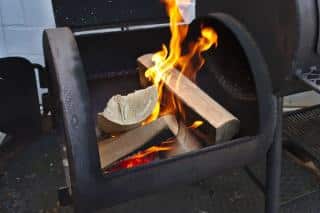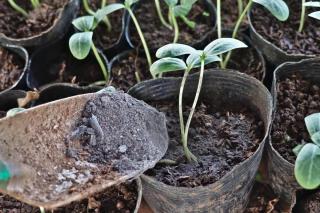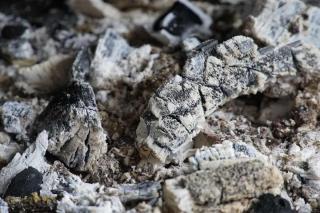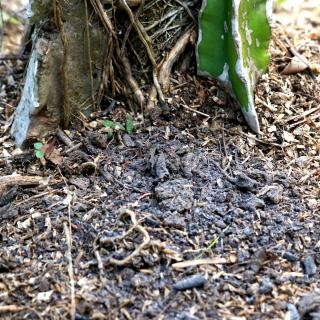

Ash can be extremely useful in your garden and for your plants since it becomes an exceptional fertilizer. Be they from the chimney in winter when logs heat your home, in fall after having burned leaves and old wood or in spring after your annual “Spring cleaning”, ashes are not to go about unused in the garden and vegetable patch.
Whether your source is a wood log fire or a pile of grass and leaves, there are many advantages to using ashes:
 Short answer: not just any kind. There are a few rules to follow, and the most important one is to only use ash from completely healthy wood. You must hence strike out:
Short answer: not just any kind. There are a few rules to follow, and the most important one is to only use ash from completely healthy wood. You must hence strike out:
Wood charcoal is fine, but you should know that coal ash (including lumps used for the barbecue) is not recommended. Indeed, it contains heavy metals and sulfur-derived compounds. These leached into underground coal veins from surrounding rock over eons. Sometimes coal lumps are treated with dangerous chemical additives to make lighting the barbecue easier, but it’s very unhealthy both for us and for plants.
As for ash that comes from burning herbaceous plants, there aren’t any restrictions: you can use them at will. Interestingly, they don’t have the same components as wood ash. They typically contain much more silica, potash, a little bit of phosphorus, and magnesium. All these elements are perfectly suited to the needs of vegetable patch plants.
Wood ash, on the other hand, contain lots of calcium salts, which makes it perfect for correcting soil acidity. As a result, it’s not a good practice to spread it around heath plants.
It all depends on what you intend to use them for:
 For use as fertilizer, it is often preferable to sprinkle it on the ground just before planting. This is because any minerals inside the ashes are soluble and will quickly wash out with each rain and watering session. This phenomenon is called lixiviation, and a trick to compensate this for your garden and veggie patch is to sprinkle them often in small amounts.
For use as fertilizer, it is often preferable to sprinkle it on the ground just before planting. This is because any minerals inside the ashes are soluble and will quickly wash out with each rain and watering session. This phenomenon is called lixiviation, and a trick to compensate this for your garden and veggie patch is to sprinkle them often in small amounts.Smart tip: you don’t need to sprinkle the ashes as a dry dust on the soil. An easy trick that works just as well is to add the ashes to water, mix it well. Nutrients dissolve into the water, and you can easily filter any inert residues out. Use this mix to water your plants and vegetables, while providing lots of nutrients.
 This topic sometimes leads to heated debates, but it all boils down to how it’s done: it’s not impossible. The key word here is moderation. Only sprinkle a thin veil of ashes between layers of plant material, and rake it in with a cultivator or firm rake. Really be careful to not put too much. If you overload it, the pack of ashes will react with moisture and will form an impenetrable film that hinders proper air circulation within the compost. If ever you’re not quite sure, it’s best to avoid walking along this path.
This topic sometimes leads to heated debates, but it all boils down to how it’s done: it’s not impossible. The key word here is moderation. Only sprinkle a thin veil of ashes between layers of plant material, and rake it in with a cultivator or firm rake. Really be careful to not put too much. If you overload it, the pack of ashes will react with moisture and will form an impenetrable film that hinders proper air circulation within the compost. If ever you’re not quite sure, it’s best to avoid walking along this path.
To go about recycling ashes in the garden and vegetable patch, here are a few rules to guide you:
 It is a fact that ashes, just like flax mulch, sticks to the underbelly of slugs and slows them down. For that, you must create small barriers 1 inch (2 to 3 cm) high around the most sensitive plants. It only works as long as the ashes aren’t wet, since water will turn the ashes into a paste and they won’t stop slugs anymore. This practice mostly works in dry weather. There’s more on organic slug control techniques here.
It is a fact that ashes, just like flax mulch, sticks to the underbelly of slugs and slows them down. For that, you must create small barriers 1 inch (2 to 3 cm) high around the most sensitive plants. It only works as long as the ashes aren’t wet, since water will turn the ashes into a paste and they won’t stop slugs anymore. This practice mostly works in dry weather. There’s more on organic slug control techniques here.
To a certain degree, ashes also interfere with ants. This makes them less likely to invade plants… where they tend to flocks of aphids!
Get a crate or metal pail and set it near the entrance to your garden, near a shed or a place you often walk by when doing garden work. Keep a trowel, empty coconut shell, or cut bottle in the pail. Every time you pass by, scoop some ash up and sprinkle it in a different portion of the garden. That way, you’re sure to not overload your flower beds!